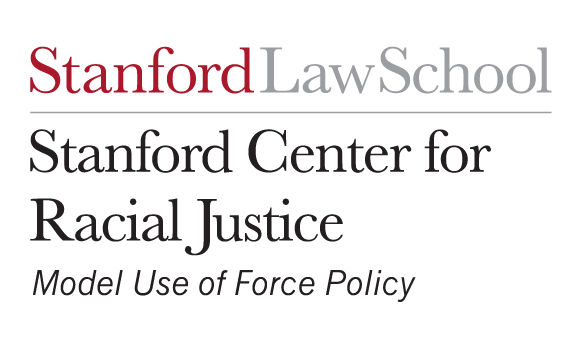Introducing Our Model Use of Force Policy Beta Release

The Stanford Center for Racial Justice (SCRJ) is excited to announce the beta release of its newly developed Model Use of Force Policy, a collaboration with an experienced team of lawyers and former prosecutors with a major global law firm, along with other law enforcement and policy experts. Together, the team has reviewed over 100 cities’ existing use of force policies, various models, state guidelines, and existing laws to develop SCRJ’s Model Policy.
Over at least the past 50 years, use of force by police has been sharply debated. The history of these tensions also has led to reports, research, guidelines, and policy advocacy coming from a wide array of sources. Accordingly, there is a growing need for law enforcement policies that comprehensively address fair, safe, and equitable practices to reduce fatal and non-fatal uses of force. The Model Policy is intended to contribute to the long line of efforts to improve and reform policing and promote practices that will be fair, safe, and equitable for everyone.
In an introductory essay that details SCRJ’s motivations for developing its Model Policy, Executive Director George Brown explains how personal and professional experiences led him to reflect on ways the Center could address the challenge of police reform. These include work with the New Era in Public Safety: A Guide to Fair, Safe and Effective Community Policing in March 2019 and a public safety advisory committee for Santa Monica, California in 2020. Amid so many unnecessary deaths, particularly of Black people who interact with police, Brown said it’s clear that we need to do better to “make our society safer for everyone.”
“It’s very difficult for community groups, civilians, and even local government officials, to engage in a detailed dialogue on equal footing with their local police agencies about how to change and improve local use of force policies,” Brown wrote in his essay. “In addition to the frequent resistance to change or even discussion about change, there is a gap in the expertise required to negotiate a detailed revision to a use of force policy. Consequently, I decided to collaborate with some of my former law colleagues and develop a Model Policy that could be easily adopted and used by similar groups and smaller cities.”
We expect to remain in a beta release phase for the rest of the calendar year. During this phase, SCRJ will be seeking continuous feedback from experts, community groups, law enforcement, and other stakeholders—particularly those who are most impacted by public safety and policing issues.
We will soon begin releasing individual Model Policy chapters, along with accompanying explanatory materials including fact sheets and blog posts that offer additional legal and policy context for each chapter, information on each chapter’s intended use, and external factors that may complement or influence the implementation of the Model Policy.
Looking ahead, the Model Policy will be updated with revisions and additional information as the project expands. Additionally, we hope that the Model Policy will become a broadly used standard that law enforcement agencies can use to measure the extent to which their policies meet the standard of being fair, safe, and equitable for all.
For additional information, please refer to the Frequently Asked Questions section of our Model Policy website or download our Fact Sheet.
— Denise Chandler, Project Leader for the Model Use of Force Policy
